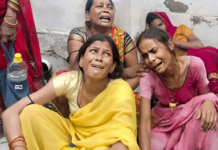यह एक ज्ञात तथ्य है कि लगभग 50 प्रतिशत पहली शादियाँ, 60 प्रतिशत दूसरी शादियाँ और 73 प्रतिशत तीसरी शादियाँ तलाक में समाप्त होती है। विषाक्त संबंध में रहने की तुलना में तलाक आम सम्मानजनक विकल्प है।
हालांकि, कुछ समुदायों में तलाक को कलंक बराबर माना जाता है परन्तु संयुक्त राज्य अमेरिका जैसे देश में भी, जहां, औसतन, लगभग 40 से 50 प्रतिशत विवाहित जोड़े तलाक लेते हैं। दक्षिण एशियाई अमेरिकियों का अप्रवासी समुदाय में काफी कम तलाक की दर है।
दक्षिण एशियाई समुदाय तलाक की इस कम दर को बहुत ही गर्व की बात मानता है, लेकिन अमेरिका की तुलना में इस तरह की कम दरों का कारण स्वस्थ, अनुकूल रिश्ते के अधिक मामलों के कारण नहीं है, बल्कि पारिजात देशपांडे, एक नैदानिक रूप से प्रशिक्षित चिकित्सक, इसे “अदृश्य तलाक” कहते हैं।
अदृश्य तलाक क्या है?
अदृश्य तलाक एक रिश्ते में एक जोड़े का एक यातनापूर्ण सहवास। ऐसे रिश्ते पूरी तरह से बिखर चुके होते हैं।

सरल शब्दों में, अदृश्य तलाक एक ऐसी स्थिति है जिसमें जब एक जोड़े को कानूनी रूप से विवाहित माना जाता है, पर साथी अब भावनात्मक या शारीरिक अंतरंगता को साझा नहीं करते हैं जैसा कि उन्होंने एक बार किया था। उनका जीवन एक दूसरे के साथ समानांतर में आगे बढ़ना है -वर्कर्स या रूममेट्स की तरह।
दक्षिण एशियाई अमेरिकियों के समुदाय से संबंधित जोड़े सांस्कृतिक और वित्तीय कारणों से या अपने बच्चों की ख़ातिर कानूनी रूप से अलग नहीं होना पसंद करते हैं।
Also Read: Indians Are Now Monetizing And Earning Money From Their Own Weddings
अदृश्य तलाक के वित्तीय पहलू
दक्षिण एशियाई समुदायों में अक्सर महिलाएं आर्थिक रूप से अपने पति पर निर्भर होती हैं। तलाक से संबंधित वर्जना का उन महिलाओं के लिए विशेष रूप से गंभीर परिणाम होता है जिनके पास स्वयं का कोई वित्तीय संसाधन नहीं है।
कई मामलों में महिलाओं के परिवार तलाक के उनके फैसले में उनका समर्थन नहीं करते हैं, और इस प्रकार, उन्हें अपने रिश्तों में रहने के लिए मजबूर किया जाता है। यदि वे अन्यथा करते हैं, तो उन्हें जाने के लिए कोई जगह नहीं बचती है और अपने और अपने बच्चों के समर्थन का कोई साधन नहीं रहता है।

इसलिए, कई दक्षिण एशियाई महिलाएं अपने सहयोगियों से अलग जीवन जीना पसंद करती हैं, लेकिन अस्वस्थ शादी के मामले में कानूनी रूप से तलाक नहीं लेने का विकल्प चुनती हैं, क्योंकि सामाजिक, भावनात्मक और आर्थिक सहित विवाहित रहने के कई फायदे हैं।
इस समस्या को ठीक करने के लिए दक्षिण एशियाई समुदाय को विवाह की संस्था पर पुनर्विचार करना चाहिए और इस पर जोर देना चाहिए ताकि लोग अपनी पसंद में अधिक स्वतंत्र और आत्मनिर्भर हो सकें।
Image Sources: Google Images
Sources: The Washington Post, The New York Times, Parijat Deshpande
Written Originally In English By: @darshanaaaac
Translated in Hindi By: @innocentlysane
This post is tagged under: Indian Marriage Age, Age For Marriage In India, Increase In Marital Age, Increase Marriage Increase Age For Women, Is Marital Age Of Women Increased, What Is The Age Of Marriage In India For Girls And Boys, Child Marriage, Maternal Mortality Rate, MMR, Fertility Rate, Death At Childbirth, Female Workforce, Will Increase In Marriage Age Be Good, Financial Pressure On Families, Women Contributing To GDP, Women In Workforce India, Women Financial Contribution To Household, Divorce, Divorce Rate, Divorce In India, Divorce Rate In India, NRI, Non Resident Indian, Indian Diaspora, South Asian Community in America, South Asian Americans, South Asian Diaspora, Marriages, Weddings, Indian Weddings, Pakistani Weddings, Bangladeshi Weddings, Sri Lankan Weddings, Indian Household Abroad, Pakistani Household Abroad, Bangladeshi Weddings, Sri Lankan Weddings, Parijat Deshpande, Immigrant Community Of South Asian Americans, Divorce Rate In America, American Marriages, American Divorces, InvisibleDivorce, the immigrant community of South Asian Americans has a low divorce rate, tortured cohabitation of a couple in a relationship that has irrevocably fallen apart, relationship between co-workers or roommates, South Asian not legally separated due to cultural, financial reasons, successful marriage is one of the most important things in life, importance of marriage, financially dependent, financial issues, together because financial issues, toxic relationships, unhealthy relationships, abusive relationships, broken marriages, societal pressure, victim blaming, ostracisation from the community, immigration, class, gender, religion, intergenerational status, rethink the institution of marriage, the institution of marriage, marriage, independent and self-determinate, more independent and self-determinate in choices, for the sake of their children, does more harm than good, does more harm than good for children, toxic relationship between parents does more harm than good for the children, stigma around divorce, heavyweight stigma around divorce, Desis Abroad, Desi Culture, Desi In American, Brown Indians, Brown Munde, American Desi, Dil Hai Hindustani, Saare Jahan Se Accha Hindustan Humara, Empty Nest Syndrome, Fear Of Missing Out, Independent Children, Indian Parents, Letting Go, Mollycoddling, Why Indian Parents Have Trouble Letting Go Of Their Kids, Importance Of Community, Community, Why Community Is Important, Why A Sense Of Shared Community Is Important, Why A Sense Of Community Is Important
Other Recommendations:
Why Do Indian Parents Have So Much Trouble Letting Go Of Their Kids?





























